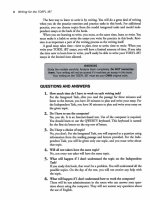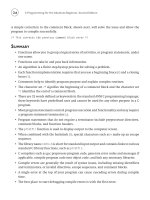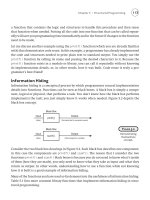Programming Groovy dynamic productivity for the java developer phần 2 potx
Bạn đang xem bản rút gọn của tài liệu. Xem và tải ngay bản đầy đủ của tài liệu tại đây (235.81 KB, 31 trang )
TEST -DRIVE USING GROOVYSH 32
The next step is to set the GROOVY_HOME environment variable and
the path. Depending on the shell you use, you have to edit different
profile files. You probably know where to go—refer to the appropriate
documentation if you need help figuring out what to edit. I use bash,
so I edited th e ~/.bash_profile file. In that file, I added an entry ex p o rt
GROOVY_HOME="/opt/groovy/groovy-1.5.4" to set the environment variable
GROOVY_HOME. Also add $GROOVY_HOME/bin to the path environment
variable.
Next, confirm that the environment variable JAVA_HOME is pointing to
the location of your JDK directory (if it’s not present, set it). ls -l ‘which
java‘ should help you determine the location of your Java installation.
That’s pretty much all you have to do. Remember to close any open
terminal windows because changes to environment variables don’t take
effect until you reopen the windows.
3
In a new terminal window, type
the command groovy -v, and make sure it reports version 1.5.4. That’s
all there is to it!
2.3 Test-Drive Us i ng groovysh
OK, you’ve installed Groovy and checked the version—it’s time to take
it for a test-drive. The quickest way to play with Groovy is to use
the command-line tool groovysh. Open a terminal window, and type
groovysh; you’ll see a shell as shown in Figure
2.1, on the next page.
Go ahead an d type some Groovy statements to see how it works.
groovysh is a good tool for interactively trying out small Groovy code
examples. It i s also useful for experimenting with some code while
you’re in the middle of coding.
4
The groovysh command compiles and
executes completed statements as soon as you hit the Enter/Return
key, and it prints the result of that stat ement execution along with any
output from the execution.
If you type Math .sqrt(16), for example, it prints the result 4.0. However, if
you ty pe println ’Test drive Groovy’, it prints the wor ds in quotes followed
by null—indicating that println( ) returned nothing.
3. If you like, you can source your profile file i nstead, but launching another terminal
window is darn cheap, so why bother?
4. Be aware, however, that groovysh has some idiosyncrasies. If you run into problems
with it, use the save command to save the code to a file and then try running from the
command line using the groovy command to get around any tool-related issues.
USING GROOVYCONSOLE 33
Figure 2.1: Using the groovysh command-line tool
You can also type code that spans multiple lines—simply use a semi-
colon at the end of the lin e if it complains, as I’ve done in the line
defining the dynamic method isPalindrome( ). When you type a class, a
method, or even an if statement, groovysh has to wait until you finish in
order to execute that code. You’ll see that it tells you how many lines it
has accumulated for execution next to the groovy: prompt.
Type help to get a list of supported commands. You can use the up
arrow to view commands you have already typed, which is useful for
repeating statements or commands. It even remembers commands you
typed from previous invocations.
When you’re done, type exit to exit from the tool.
2.4 Using groovyConsole
If you’re not a command-line person and inst ead prefer a GUI, Groovy
has got you covered—simply double-click groovyConsole.bat in Windows
Explorer (you’ll find it in the %GROOVY_HOME%\bin directory). Users of
Unix-like systems can double-click the groovyConsole executable script
using their favorite file/directory-browsing tool. A console GUI will pop
up, as shown in Fig ure
2.2, on the following page.
Go ahead and ty pe some Groovy code in the top window of the console.
When you’re ready to execute th e code, press Ctrl +R or Ctrl+Enter on
your Windows system or Command+R or Command+Enter on your Mac
system.
RUNNING GROOVY ON THE COMMAND LINE 34
Figure 2.2: Using groovyConsole
You can also click the appropriate toolbar button to execute your script.
The groovyConsole command has grown fancier over time—you can save
your script, open existing scripts, and so on, so take some time to
explore the tool.
2.5 Running Groovy on the Command Line
Of course, nothing can give you as much pleasure as getting into the
command line and runnin g the program from there, right? You can do
that by typing the command groovy followed by the Groovy program
filename, as shown in Fi gure
2.3, on the next page.
If you want to try a couple of statements directly on the command line,
you can do that by using the -e option. Type groovy -e "pr i ntln ’hell o ’" on
the command line, and hit Enter/Return. Groovy will output “hello.”
You can get a bit fancier and even pass command-line arguments, as
shown here:
groovy -e
'println "Hello, ${args[0]}. ${args[1]}"'
Buddy
'Have a nice day!'
Groovy will report the following:
Hello, Buddy. Have a nice day!
Realistically, though, the groovy command is useful to execute large
Groovy scripts and classes. It expects you to either have some exe-
cutable code outside any class or have a class with a static main(String[ ]
args) method (the traditional Java main( ) method).
USING AN IDE 35
Figure 2.3: Running from the command line
You can also skip the main( ) method if your class extends GroovyTestCase
(see Section 16.2, Unit Testing Java and Groovy Code, on page 236 for
more information) or if your class implements the Runnable interface.
5
2.6 Using an IDE
You’ll be happy to hear th at you’ll quickly graduate fr om the two tools
we’ve talked about so far. Therefore, once you start churning out Groovy
code, you’ll w ant to use an IDE. Fortunately, you have several IDEs to
choose from for coding Groovy. See
/>for some choices. You can edit your Groovy code, run it from within
your IDE, debug your code, and a lot more depending on which tool
you pick.
IntelliJ IDEA and JetGroovy
IntelliJ IDEA offers outstanding support for Groovy through the Jet-
Groovy plug-in ( Using it, you can edit
Groovy code, take advantage of code completion, get support for Groovy
builders, use syntax and error highlight i ng, use code format ting and
inspection, jointly compile Java and Groovy code, refactor and debug
both Java and Groovy code, and work with and build Java and Groovy
code in the same project. It also supports Grails projects with built-in
Grails generators and GSP code completion and assistance.
Eclipse Groovy Plug-In
If you are an E clipse user, you can use the Groovy Eclipse plug-in
( This plug-in allows you to edit
Groovy classes and scripts, take advantage of syntax highlighting, and
compile and run the code and tests. Using the Eclipse Debugger, you
5. If the main( ) method is present in these cases, it takes precedence.
USING AN IDE 36
Figure 2.4: Groovy code executed within TextMate
can step into Groovy code or debug unit tests. In addition, you can
invoke the Groovy shell or Groovy console from within Eclipse to quickly
experiment with Java and Groovy code.
TextMate Groovy Bundle
As a Mac user, I use the Groovy bundle ( />GROOVY/TextMate) in TextMate (, [Gra07]) exten-
sively.
6
It provides a number of time-saving snippets that allow code
expansion for standard Groovy code such as closures. You can take
advantage of syntax highlighting and run Groovy code and tests quickly
from within TextMate,
7
as shown in Fig ure
2.4.
It’s nice to have a choice of command-line and IDE tools. However, you
need to decide which tool is right for you. Personally, I find it easier to
simply run Groovy code directly from within the editor or IDE, letting
the groovy tool take care of compiling and executing the code behind th e
scene. That helps with my “r apid edit, code, and run-my-tests” cycle.
At times, I find myself jumping over to groovysh to experiment with code
snippets. But you don’t have to do what I do. The right tool for you is
the one you’re most comfortable with. Start with a simple tool and the
steps that work for you. Once you get comfortable, you can always scale
up to something more sophisticated when you need to do so.
In this chapter, you installed Groovy and took it for a quick test -drive.
Along the way you looked at a few command-line tools and IDE support.
That means you’re all set to explore Groovy in the next chapter.
6. Windows users—take a look at E Text Editor at . Also, for
editing small code snippets, you can use Notepad2 (see
/>7. See my blog entry at
for a minor tweak to quickly display results
without a pop-up window.
Chapter
3
Groovy for the Java Eyes
I’ll help you ease into Groovy in this chapter. Specifically, we’ll st art
on familiar ground and then transition into the Groovy way of writ-
ing. Since Groovy preserves Java syntax and semantics, you can mix
Java style and Groovy style at will. And, as you get comfortable with
Groovy, you can make your code even groovier. So, get ready for a tour
of Groovy. We’ll wrap this chapter with some “gotchas”—a few things
that might catch you off guard if you aren’t expecting them.
3.1 From Java to Groovy
Groovy readily accepts your Java code. So, start with the code you’re
familiar with, but run it through Groovy. As you work, figure out elegant
and Groovy ways to write your code. You’ll see that your code is doing
the same things, but it’s a lot smaller. It’ll feel like your refactoring is
on steroids.
Hello, Groovy
Here a Java sample that’s also Groovy code:
// Java code
public class Greetings
{
public static void main(String[] args)
{
for(int i = 0; i < 3; i++)
{
System.out.
print(
"ho "
);
}
System.out.
println(
"Merry Groovy!"
);
}
}
FROM JAVA TO GROOVY 38
Default Imports
You don’t have to import some common classes/packages
when you write Groovy code. For example, Calendar read-
ily refers to java.util.Calendar. Groovy automatically imports
the following Java packages: java.lang, java.util, java.io,
and java.net. It also imports the classes java.math.BigDecimal
and java.math.BigInteger. In addition, the Groovy p ackages
groovy.lang and groovy.util are imported.
The output from the previous code is as follows:
ho ho ho Merry Groovy!
That’s a lot of code for such a simple task. Still, Groovy will obediently
accept and execute it. Simply save that code to a file named Greet-
ings.groovy, and execute it using the command groovy Greetings.
Groovy has a higher signal-to-noise ratio. Hence, less code, more result.
In fact, you can get rid of most of the code from the previous pr ogram
and still have it produce the same result. Start by removing the line-
terminating semicolons first. Losing the semicolons not only reduces
noise, but it also helps to use Groovy to implement internal DSLs
(Chapter
18, Creating DSLs in Groovy, on page 277).
Then remove the class and method definition. Groovy is still happy (or
is it happier?).
Download GroovyForJavaEyes/LightGreetings.groovy
for(int i = 0; i < 3; i++)
{
System.out.print(
"ho "
)
}
System.out.
println(
"Merry Groovy!"
)
You can go even furth er. Groovy understands println( ) because it has
been added on java.lang.Object. It also has a lighter form of the for loop
that uses the Range object, and Groovy is lenient with parentheses. So,
you can reduce the previous code to the following:
Download GroovyForJavaEyes/LighterGreetings.groovy
for(i in 0 2) { print
'ho '
}
println
'Merry Groovy!'
FROM JAVA TO GROOVY 39
The output from the previous code is the same as the Java code you
started with, but the code is a lot lighter. That just goes to show you
that simple things are simple to do in Groovy.
Ways to Loop
You’re not restricted to the traditional for loop in Groovy. You already
used the range 0 2 in the for loop. Wait, there’s more.
1
Groovy has added a convenient upto( ) instance method to java.lang.
Integer, so you can loop using that method, as shown here:
Download GroovyForJavaEyes/WaysToLoop.groovy
0.upto(2) { print
"$it "
}
Here you called upto( ) on 0, which is an instance of Integer. The output
from the previous code is as follows:
0 1 2
So, what’s that it in the code block? In this context, it represents the
index value through the loop. The upto( ) method accepts a closure as a
parameter. If the closure expects only one parameter, you can use the
default name it for it in Groovy. Keep that in mind, and move on for
now; we’ll discuss closures in more detail in Chapter 5, Using Closures,
on page
92. The $ in front of the variable it tells the method println( ) to
print the value of the variable instead of the character s “it”—it allows
you to embed expressions within strings, as you’ll see in Chapter 6,
Working with Strings, on page 111.
The upto( ) method allows you to set both lower and upper limits. If you
start at 0, you can also use the times( ) method, as shown here:
Download GroovyForJavaEyes/WaysToLoop.groovy
3.times { print
"$it "
}
The output from previous code is as follows:
0 1 2
If you want to skip values while looping, use the step( ) method:
Download GroovyForJavaEyes/WaysToLoop.groovy
0.step(10, 2) { print
"$it "
}
The output from the previous code is as follows:
0 2 4 6 8
1. />FROM JAVA TO GROOVY 40
You’ve now seen simple looping in action. You can also iterate or tra-
verse a collection of objects using simil ar methods, as you’ll see later in
Chapter 7, Working with Collections, on page 124.
To go further, you can rewrite the greetings example using the methods
you learned earlier. Look at how short the following Groovy code is
compared to the Java code you started with:
Download GroovyForJavaEyes/WaysToLoop.groovy
3.times { print
'ho '
}
println
'Merry Groovy!'
To confirm, the output from the previous code is as follows:
ho ho ho Merry Groovy!
A Quick Look at the GDK
Groovy extends the JDK with an extension called the GDK
2
or the
Groovy JDK. I’ll whet your appetite here with a quick example.
In Java, you can use java.lang.Process to interact with a system-level
process. Suppose you want to invoke Subversion’s help from within
your code; well, here’s the Java code for that:
//Java code
import java.io.
*
;
public class ExecuteProcess
{
public static void main(String[] args)
{
try
{
Process proc = Runtime.getRuntime().exec(
"svn help"
);
BufferedReader result = new BufferedReader(
new InputStreamReader(proc.getInputStream()));
String line;
while((line = result.readLine()) != null)
{
System.out.println(line);
}
}
catch(IOException ex)
{
ex.printStackTrace();
}
}
}
2. />FROM JAVA TO GROOVY 41
java.lang.Process is very helpful, but I had to jump t hrough some hoops
to use it in the previous code; in fact, all th e exception-handling code
and effort to get to the output makes me dizzy. But the GDK, on the
other hand, makes this insanely simple:
Download GroovyForJavaEyes/Execute.groovy
println
"svn help"
.execute().text
Compare the two pieces of code. They remind me of the sword-fight
scene
3
from the movie Raiders of the Lost Ark; the Java code is pulling
a major stunt like the villain with the sword. Groovy, on the other hand,
like Indy, effortlessly gets the job done. Don’t get me wrong—I am cer-
tainly not calling Java the villain. You’re still using Process and the JDK
in Groovy code. Your enemy is the unnecessary complexity that makes
it harder and time-consuming to utilize the power of the JDK and the
Java platform.
Which of the previous two versions would you prefer? The short and
sweet one-liner, of course (unless you’re a consultant who gets paid by
the number of lines of code you write ).
When you called the execute( ) method on the instance of String, Groovy
created an instance that extends java.lang.Process, just like the exec( )
method of Runtime did in the Java code. You can verify this by using the
following code:
Download GroovyForJavaEyes/Execute.groovy
println
"svn help"
.execute().getClass().name
The output from the previous code, when run on a Unix-like machine,
is as follows:
java.lang.UNIXProcess
On a Windows machine, you’ll get this:
java.lang.ProcessImpl
When you call text, you’re calling the Groovy-added method getText( ) on
the Process to read the process’s entire standard output into a String.
4
Go ahead, try the previous code.
3. />4. If you simply want to wait for a process to finish, use either waitFor( ) or the Groovy-
added method waitForOrKill( ) that takes a timeout in milliseconds.
FROM JAVA TO GROOVY 42
If you don’t use Subversion, substitute svn he l p with some other pro-
gram on your system (such as groovy -v), as shown here:
Download GroovyForJavaEyes/Execute.groovy
println
"groovy -v"
.execute().text
The output from the previous code is as follows:
Download GroovyForJavaEyes/Execute.output
Groovy Version: 1.5.4 JVM: 1.6.0_01-41-release
This code sample works on Unix-like systems and on Windows.
Similarly, on a Unix-like system, to get the listing of current direct ory,
you can call ls:
Download GroovyForJavaEyes/Execute.groovy
println
"ls -l"
.execute().text
If you’re on Windows, simply replacing ls with dir will not work. The
reason is that alth ough l s is a program that you’re executing on Unix-
like systems, dir is not a program—it’s a shell command. So, you have
to do a little more than calling dir. Specifically, you need to invoke cmd
and ask it to execute the dir command, as shown here:
Download GroovyForJavaEyes/Windows/ExecuteDir.groovy
println
"cmd /C dir"
.execute().text
In this section, you’ve merely scratched the surface of the GDK. You can
find more GDK goodness in Chapter 8, Exploring the GDK, on page 141.
Safe Navigation Operator
Groovy has a number of little features that are exciting and help ease
the development effort. You’ll find them throughout this book—one
such feature is the safe navigation operator (?.). It eliminates the mun-
dane check for null, as shown in the following code:
Download GroovyForJavaEyes/Ease.groovy
def foo(str)
{
//if (str != null) { return str.reverse() }
str?.reverse()
}
println foo(
'evil'
)
println foo(null)
FROM JAVA TO GROOVY 43
The ?. operator in method foo( )
5
calls the method or property only if the
reference is not null. The output from the previous code is as follows:
live
null
The call to reverse( ) on the null reference using ?. resulted in a null instead
of a NullPointerException—another way Groovy reduces noise.
Exception Handling
I mentioned that Groovy has less ceremony than Java. One area where
that’s crystal clear is in exception handling. Java forces you to handle
checked exceptions. Consider a simple case: you want to call Thread’s
sleep( ) method.
6
Java forces you to catch java.lang.InterruptedException.
What does any respectable Java developer do when forced to do things?
They find a way around doing it. The result? Lots of empty catch blocks,
right? Check this out:
Download GroovyForJavaEyes/Sleep.java
// Java code
try
{
Thread.sleep(5000);
}
catch(InterruptedException ex)
{
// eh? I'm losing sleep over what to do here.
}
Having an empty catch block is worse than not handling an exception.
If you put an empty catch block, you’re suppressing the exception. If
you don’t handle it in the first place, it is propagated to the c aller who
either can do something about it or can pass it yet again to its caller.
Groovy does not force you to handle exceptions that you don’t want to
handle or that are inappropriate at your level. Any exception you don’t
handle is automatically passed on to a higher level. Here’s an example
of Groovy’s answer to exception handling:
Download GroovyForJavaEyes/ExceptionHandling.groovy
def openFile(fileName)
{
new FileInputStream(fileName)
}
5. Programming books are required to have at least one method named “foo.”
6. Groovy provides an alternate sleep( ) method; see Section 8.1, sleep, on page 144.
FROM JAVA TO GROOVY 44
The method openFile( ) does not handle the infamous FileNotFoundExcep-
tion. If the exception occurs, it is not suppressed. In stead, it’s passed to
the calling code, which can handle it, as shown here:
Download GroovyForJavaEyes/ExceptionHandling.groovy
try
{
openFile(
"nonexistentfile"
)
}
catch(FileNotFoundException ex)
{
// Do whatever you like about this exception here
println
"Oops: "
+ ex
}
If you are interested in catching all Exceptions that may be thrown, you
can write a catch, as shown here:
Download GroovyForJavaEyes/ExceptionHandling.groovy
try
{
openFile(
"nonexistentfile"
)
}
catch(ex)
{
// Do whatever you like about this exception here
println
"Oops: "
+ ex
}
I used catch(ex) without any type in fr ont of the variable ex so I can
catch just about any exception t hrown my way. Beware, this doesn’t
catch Errors or Throwables other than Exceptions. To really catch all of
them, use catch(Throwable t).
As you can see, Groovy allows you to focus on getting your work done
rather than tackling annoying system-level details.
Groovy as Lightweight Java
Groovy has other features that make it lighter and easier to use. Here
are some:
• The return statement is almost optional (see Section 3.8, Gotchas,
on page 67).
• ; is almost optional though can be used to separate statements
(see Section
3.8, The Semicolon (;) Is Almost Optional, on page 73).
• Methods and classes are public by default.
JAVABEANS 45
• The ?. operator dispatches calls only i f the object reference is not
null.
• You can in i tialize JavaBeans using named parameters (see Sec-
tion
3.2, JavaBeans).
• You’re not forced to catch exceptions that you don’t care to handle.
They get passed to the caller of your code.
• You can use this within static methods to refer to the Class object.
For example, in the following code, the learn( ) methods return the
class so you can chain calls to learn( ) methods:
class Wizard
{
def static learn(trick, action)
{
//
this
}
}
Wizard.learn(
'alohomora'
, {/
*
*
/})
.learn(
'expelliarmus'
, {/
*
*
/})
.learn(
'lumos'
, {/
*
*
/})
3.2 JavaBeans
The story of JavaBeans is interesting. When the concept was intro-
duced, it was exciting. It was declared that Java objects would be con-
sidered JavaBeans if they followed certain conventions and th at they
would carry p roperties. That raised a lot of excitement and hope. But
when it came to accessing these properties, I found that calls to mere
getters and setters were required. My excitement came crashing down,
and developers moved on to create thousands of silly methods in t heir
applications.
7
If JavaBeans were human, they’d be on Prozac.
8
Groovy treats JavaBeans wi th the respect they deserve. In Groovy, a
JavaBean truly has properties. Let’s start with Java code and reduce it
to Groovy so you can see what I mean.
7. />8. To be fair, the intent of JavaBean is noble—it made component-based development,
application assembling, and integration practical and paved the way for exceptional IDE
and plug-in development.
JAVABEANS 46
Download GroovyForJavaEyes/Car.java
//Java code
public class Car
{
private int miles;
private int year;
public Car(int theYear) { year = theYear; }
public int getMiles() { return miles; }
public void setMiles(int theMiles) { miles = theMiles; }
public int getYear() { return year; }
public static void main(String[] args)
{
Car car =
new Car(2008);
System.out.println(
"Year: "
+ car.getYear());
System.out.println(
"Miles: "
+ car.getMiles());
System.out.println(
"Setting miles"
);
car.setMiles(25);
System.out.println(
"Miles: "
+ car.getMiles());
}
}
That’s all too familiar Java code, isn’t it? The output from the previous
code is as follows:
Year: 2008
Miles: 0
Setting miles
Miles: 25
Let’s rewrite the code in Groovy:
Download GroovyForJavaEyes/GroovyCar.groovy
class Car
{
def miles = 0
final year
Car(theYear)
{
year = theYear
}
}
Car car =
new Car(2008)
JAVABEANS 47
println
"Year: $car.year"
println
"Miles: $car.miles"
println
'Setting miles'
car.miles = 25
println
"Miles: $car.miles"
That code does the same thing (see the following output), but it has less
clutter and ceremony.
Year: 2008
Miles: 0
Setting miles
Miles: 25
def declared a property in this context.
9
Groovy quietly created a getter
and setter method for you behind the scenes (just like how a construc-
tor is created in Java if you don’t write any). When you call mile s in your
code, you’re not referencing a field; instead, you’re calling the getter
method for the miles property. If you want a property to be read-only,
then declare it final. This is not defining a final field but a read-only
property—you can change the property from within instance methods
of the defining class, but not from outside. Groovy provides a getter in
this case and no setter. You can verify these concepts with the following
code:
Download GroovyForJavaEyes/GroovyCar2.groovy
class Car
{
final miles = 0
def getMiles()
{
println
"getMiles called"
miles
}
def drive(dist) { if (dist > 0) miles += dist }
}
You declared miles as final; however, you can change it from within the
drive( ) instance method. Let’s use this class now.
9. You c an declare properties by either using def as in the example or giving the type
(and optional value) as in int miles or int miles = 0.
JAVABEANS 48
Download GroovyForJavaEyes/GroovyCar2.groovy
def car = new Car()
println
"Miles: $car.miles"
println
'Driving'
car.drive(10)
println
"Miles: $car.miles"
try
{
'Can I set the miles? '
car.miles = 12
}
catch(groovy.lang.ReadOnlyPropertyException ex)
{
println ex.message
}
The output from the previous code is as follows:
getMiles called
Miles: 0
Driving
getMiles called
Miles: 10
Can I set the miles? Cannot set readonly property: miles for class: Car
If you w ant to access properties, you don’t need to use getters or sett ers
anymore in y our call. You can see the elegance of this in the following
code:
Download GroovyForJavaEyes/UsingProperties.groovy
Calendar.instance
// instead of Calendar.getInstance()
str =
'hello'
str.class.name
// instead of str.getClass().getName()
// Caution: Won't work for Maps, Builders,
// use str.getClass().name to be safe
Use caution with the class property, however—some classes like Map
and builders give special treatment to this property (see Section 7.5,
Using Map, on page 133, for example). As a result, I recommend you
use getClass( ) instead of class to avoid any surprises.
Groovy gives you the flexibility to initialize a JavaBean class. When
constructing an object, simply give values for properties as comma-
separated name-value pairs. This is a postconstruction operation if
JAVABEANS 49
your class has a no-argument constructor. You can also design your
methods so they can take named parameters. To take advantage of this
feature, define the fir st parameter as a Map. Let’s see these in act i on:
Download GroovyForJavaEyes/NamedParameters.groovy
class Robot
{
def type, height, width
def access(location, weight, fragile)
{
println
"Received fragile? $fragile, weight: $weight, loc: $location"
}
}
robot =
new Robot(type:
'arm'
, width: 10, height: 40)
println
"$robot.type, $robot.height, $robot.width"
robot.access(50, x: 30, y: 20, z: 10, true)
The output from the previous code is shown next. Th e instance of Robot
took type, height, and width parameters as name-value pairs. In the call
to the access( ) method, you set the first parameter, weight, t o a single
value, which is an Integer. You set the last parameter, fragile, to a single
value as well. The rest of the parameters in the middle are name-value
pairs for location. The example did not quite follow th e same ordering
as in the method definition (though I recommend you do); instead, you
took advantage of some Groovy magic.
If the number of parameters you send is more than the number of
arguments the method expects and if the excess parameters are name-
value pairs, then Groovy assumes the first argument of the method
is a Map and groups all the name-value pairs together as values for
the first parameter. It then takes the rest of t he parameters, in the
presented order, as values for the remainin g parameters, as shown in
the following output:
arm, 40, 10
Received fragile? true, weight: 50, loc: [
"x"
:30,
"y"
:20,
"z"
:10]
Although the pr evious Groovy magic is quite powerful, it leads to a
problems, such as when you pass three integer arguments. In this
case, the arguments will be passed in order, no map is created from
the arguments, and the result is not what you desire.
OPTIONAL PARAMETERS 50
You can avoid confusion like this by explicitly naming th e first param-
eter as a Map, as shown here:
Download GroovyForJavaEyes/NamedParameters.groovy
def access(Map location, weight, fragile)
{
"Received fragile? $fragile, weight: $weight, loc: $location"
}
Now, if your arguments do not contain two objects plus arbitrary name-
value pairs, you will get an error.
As you can see, thanks to the makeover Groovy gave JavaBeans, they’re
quite vibrant in Groovy.
3.3 Optional Parameters
In Groovy you can make method and constructor parameters optional.
In fact, make as man y parameters optional as you like, but they have to
be trailing. To define an optional parameter, you simply give it a value in
the parameter list. Here’s an example of a log( ) functi on that allows you
to optionally give the base (if you don’t set that argument, it assumes
base 10):
Download GroovyForJavaEyes/OptionalParameters.groovy
def log(x, base=10)
{
Math.log(x) / Math.log(base)
}
println log(1024)
println log(1024, 10)
println log(1024, 2)
The output from the previous code is as follows:
3.0102999566398116
3.0102999566398116
10.0
Groovy also treats the trailing array parameter as optional. So, in the
following example, you can send zero or more values for the l ast param-
eter:
Download GroovyForJavaEyes/OptionalParameters.groovy
def task(name, String[] details)
{
println
"$name - $details"
}
IMPLEMENTING INTERF ACES 51
task
'Call'
,
'123-456-7890'
task
'Call'
,
'123-456-7890'
,
'231-546-0987'
task
'Check Mail'
The output from the previous code is as follows:
Call - {
"123-456-7890"
}
Call - {
"123-456-7890"
,
"231-546-0987"
}
Check Mail - {}
Providing mundane arguments to methods can get tiring. Optional
parameters reduce noise and allow for sensible defaults.
3.4 Implementing Interfaces
In Groovy you can morph a map or a block of code into implement-
ing interfaces. This allows you to implement int erf aces with multiple
methods quickly. In this section, I’ll show a Java way of implement-
ing interfaces, and then you’ll learn how to take advantage of Groovy’s
facilities.
Here’s the all-too-familiar Java code to register an event handler to a
Swing JButton. The call to addActionListener( ) expects an instance that
implements the ActionListener interface. So, you create an anonymous
inner class that implements ActionListener, and you provide the required
actionPerformed( ) method. This method i nsists on taking ActionEvent as
an argument even though you have no use for it in this example.
// Java code
button.addActionListener(new ActionListener()
{
public void actionPerformed(ActionEvent ae)
{
JOptionPane.showMessageDialog(frame,
"You clicked!"
);
}
});
Groovy brings a charming idiomatic difference here—no need for that
actionPerformed( ) method declaration or that explicit new anonymous
inner class instance!
button.addActionListener(
{ JOptionPane.showMessageDialog(frame,
"You clicked!"
) } as ActionListener
)
You call the addActionListener met hod and provide it with a block of code
that morphs itself to implement th e ActionListener interface because of
the as operator.
IMPLEMENTING INTERF ACES 52
That’s it—Groovy takes care of the rest. Groovy intercepts calls to any
method on the interface (actionPerformed( ), in this case) and routes it to
the block of code you provided.
10
You don’t have to do anything different if you plan to provide on e single
implementation for al l the methods of a multimethod interface.
Suppose you want to update the display of mouse location in a label as
the mouse is clicked and moved around in your application. In Java,
you have to implement a total of seven methods of the MouseL i stener and
MouseMotionListener interfaces. Since your implementation for all these
methods are the same, Gr oovy makes your life easy.
displayMouseLocation = { positionLabel.setText(
"$it.x, $it.y"
) }
frame.addMouseListener(displayMouseLocation
as MouseListener)
frame.addMouseMotionListener(displayMouseLocation as MouseMotionListener)
In th i s code, you created the variable displayMouseLocation that refers to
a block of code. You then morphed it twice using the as operator, once
for each of th e inter faces, MouseListener and MouseMotionListener. Once
again, Groovy takes care of the rest, and you can move on to focus
on other t hings. It took three lines of code instead of —sorry, I’m still
counting—in Java.
In the previous example, you see that variable it again. it represents
the method argument. If a met hod of the interface you’re implementing
takes multi ple arguments, you can define them either as discrete argu-
ments or as a parameter of type array—you’ll see how in Chapter
5,
Using Closures, on page 92.
OK, that was nice, but in most realistic situations, you’d want a differ-
ent implementation for each method of an interface. No worries, Groovy
can handle that. Simply create a map—no, you don’t have to endure
the map syntax of Java. Simply separate the method names from the
code block using a colon (:). Also, you don’t have to implement all the
methods. You implement only those you really care about. If the meth-
ods you don’t implement are never called, you didn’t waste any effort
implementing dummy stubs. Of course, if you fail to provide a method
that’s called, you’ll get a NullPointerException. Let’s put these to use in an
example.
10. If you want to try running this code, you’ll need to create the frame and its compo-
nents; the full li sting of the code is shown at the end of this section.
IMPLEMENTING INTERF ACES 53
handleFocus = [
focusGained : { msgLabel.setText(
"Good to see you!"
) },
focusLost : { msgLabel.setText(
"Come back soon!"
) }
]
button.addFocusListener(handleFocus
as FocusListener)
Whenever the button in this example gains focus, the first block of code
associated with the key focusGained will be called. When the button
loses focus, the block of code associated with focusLost is called. The
keys in this case correspond to th e methods of the FocusListenerInterface.
The as operator is good if y ou know the name of the inter face you’re
implementing. However, what if your application demands dynamic
behavior and you’ll know the interface name only at runtime? Well,
the asType( ) method comes to your rescue. You can use this method to
morph either a block of code or a map to an interface by sending the
Class metaobject of the in ter face you want to implement as an argument
to asType( ). Let’s look at an example.
Suppose you want to add an event handler for different events: Win-
dowListener, ComponentListener, the list may be dynamic. Also suppose
your handler will perform some common operation such as logging or
updating a status bar—some task to help with testing or debugging
your application. You can dynamically add handlers for multiple events
using a single block of code. Here’s how:
events = [
'WindowListener'
,
'ComponentListener'
]
// Above list may be dynamic and may come from some input
handler = { msgLabel.setText(
"$it"
) }
for (event in events)
{
handlerImpl = handler.asType(Class.forName(
"java.awt.event.${event}"
))
frame.
"add${event}"
(handlerImpl)
}
The interfaces you want to implement—t hat is, the events you want to
handle—are in the list events. This list is dynamic; suppose it will be
populated with input during code execution. The common handler for
the events is in the code block referred to by the variable handler. You
loop through the events, and for each event, you’re creating a imple-
mentation of the interf ace using the asType( ) method. This method is
called on the block of code and is given the Class metaobject of the inter-
face obtained using the fo rName( ) method. Once you have the imple-
mentation of the listener interface on hand, you can register it by call-
ing the appropriate add method (like addWindowListener( )). The call to
IMPLEMENTING INTERF ACES 54
the add method itself is dynamic. You’ll learn more about such methods
later in Section 12.2, Querying Methods and Properties, on page 190.
In the previous code, I used the asType( ) method on the block of code.
If you have different implementations for different methods, you’d have
a map i nstead of a single block of code. In that case, you can call the
asType( ) method on the map in a similar w ay. Finally, as promised, here
is the full listing of the Groovy Swing code developed in this section:
Download GroovyForJavaEyes/Swing.groovy
import javax.swing.
*
import java.awt.
*
import java.awt.event.
*
frame =
new JFrame(size: [300, 300],
layout: new FlowLayout(),
defaultCloseOperation: javax.swing.WindowConstants.EXIT_ON_CLOSE)
button =
new JButton(
"click"
)
positionLabel = new JLabel(
""
)
msgLabel = new JLabel(
""
)
frame.contentPane.add button
frame.contentPane.add positionLabel
frame.contentPane.add msgLabel
button.addActionListener(
{ JOptionPane.showMessageDialog(frame,
"You clicked!"
) } as ActionListener
)
displayMouseLocation = { positionLabel.setText(
"$it.x, $it.y"
) }
frame.addMouseListener(displayMouseLocation as MouseListener)
frame.addMouseMotionListener(displayMouseLocation
as MouseMotionListener)
handleFocus = [
focusGained : { msgLabel.setText(
"Good to see you!"
) },
focusLost : { msgLabel.setText(
"Come back soon!"
) }
]
button.addFocusListener(handleFocus
as FocusListener)
events = [
'WindowListener'
,
'ComponentListener'
]
// Above list may be dynamic and may come from some input
handler = { msgLabel.setText(
"$it"
) }
for (event in events)
{
handlerImpl = handler.asType(Class.forName(
"java.awt.event.${event}"
))
frame.
"add${event}"
(handlerImpl)
}
frame.show()
GROOVY BOOLEAN EVALUATION 55
In this section, you saw the Groovy way to implement interfaces. It
makes registering for events or passing anonymous implementations of
interfaces really simple. You’ll find the ability to morph blocks of code
and maps into interface implementations a real time-saver.
3.5 Groovy boolean Evalua t i on
The truth is that bo o l ean evaluation in Groovy is different from eval-
uation in Java. Depending on the context, Groovy will automatically
evaluate expressions as boolean.
Let’s see a specific example. The following Java code will not work:
//Java code
String obj =
"hello"
;
int val = 4;
if (obj) {} // ERROR
if(val) {} //ERROR
Java insists that you provide a boolean expression for the condition
part of the if statement. It wants if(obj != null) and if(val > 0) in the previous
example, for instance.
Groovy is not that picky. It tries to infer, so you need to know what
Groovy is thinking.
If you place an object reference wh ere a boolean expression is expected,
Groovy checks whether the reference is null. It considers null as fal se,
and true otherwise, as in the following code:
str =
'hello'
if (str) { println
'hello'
}
The output from the previous code is as follows:
hello
But, the last part about true that I mentioned earlier is not entirely true.
If the object reference is not-null, then the truth depends on the type of
the object. For example, if th e object is a collection (like java.util.ArrayList),
then Groovy checks whether the collection is empty. So, in this case, the
expression if (obj) evaluates true only if obj is not null and the collection
has at least one element, as shown in the following code example:
lst0 = null
println lst0 ?
'lst0 true'
:
'lst0 false'
lst1 = [1, 2, 3]
println lst1 ?
'lst1 true'
:
'lst1 false'
lst2 = []
println lst2 ?
'lst2 true'
:
'lst2 false'
OPERATOR OVERLOADING 56
Type Condition for truth
Boolean true
Collection not empty
Character value not 0
CharSequence length greater than 0
Enumeration has more elements
Iterator has text
Number double value not 0
Map not empty
Matcher at least one match
Object[ ] length greater than 0
any other type reference not null
Figure 3.1: Types and their special treatment for boolean evaluation
You can check your understanding of how Groovy handles boolean for
Collections with the following output:
lst0 false
lst1 true
lst2 false
Collections are not t he only things that receive special boolean treat-
ment. For the types with special treatment and how Groovy evaluates
their truth, refer to the table in Figure 3.1.
3.6 Operator Overloading
You can use Groovy’s support for operator overloading, judiciously, t o
create DSLs (see Chapter
18, Creating DSLs in Groovy, on page 277).
When Java has no support for operator overloading, how does Groovy
get away with that? It’s really simple, actually—each operator has a
standard mapping to methods.
11
So, in Java you can use those meth-
ods, and on the Groovy side you can use either the operators or their
corresponding methods.
11. For a list of operators and method mapping, visit />Operator+Overloading
.









